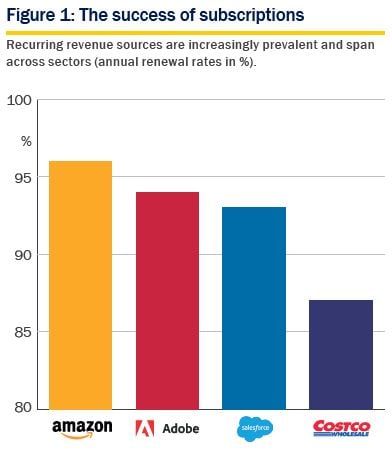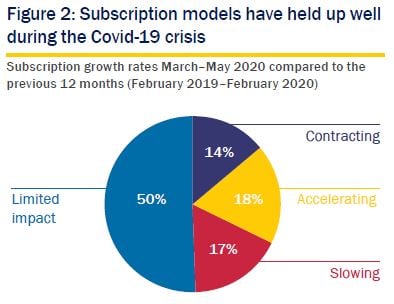Wealth Management: Instant Insights – Subscribe and stay (en anglais uniquement)

William Therlin, Amaya Gutiérrez and Christoph Wirtz, Wealth Management
Idea in brief: subscription models |
||
Part of our daily routineWidespread adoption of subscription models means they have become a part of our daily lives. |
Reaching a range of sectorsThe reach of subscription spans across industries. |
Offering competitive advantagesCompanies enjoy higher revenue predictability, higher switching costs and improved margins. |
The convenience of recurrence
From downloading your morning news journal, leasing cars and paying for the monthly gym membership, to streaming your favourite TV series at the end of day, subscription models are a ubiquitous part of modern living, keeping us company from dusk till dawn.
Three key reasons why subscription models are so popular with consumers are: (1) convenience and accessibility, (2) discount prices via subscription, and (3) personalised services driven by algorithm-tailored recommendations. For businesses, the growing popularity of subscription has presented new avenues to increase recurring revenues over time.
From software to eCommerce
Many industries have seen a significant shift towards recurring revenue sources - either through pure subscription models, maintenance or longterm contracts. These now represent a significant part of revenues for companies in sectors ranging from technology to consumer staples.
In the software industry, there are companies with both partial and full subscription models, usually those selling Software as a Service (SaaS). In 2020, it is estimated that over 80% of incumbent software vendors offer subscription models. In media and entertainment sectors, meanwhile, music, video and cable offerings have also adopted the subscription model - think Spotify or Apple Music. Growth in subscriptions has also come hand in hand with the rise of eCommerce, which has revolutionised the retail sector (for more on “bricks to clicks”, see our Instant Insights - eCommerce).
In order to fully understand the inherent power of subscription models, we must understand how they differ from traditional sales strategies.
From transactional to relational
A traditional business model anchored in the transactional economy is centred on two parts: (1) spending resources to acquire a new customer and (2) being compensated for those efforts with a purchase. This is all too often a one-time transaction. In pursuing a second transaction, a company would spend a similar amount to the initial sales expense.
At the other end of the spectrum - and at the heart of the membership economy - lies a business model based on subscriptions. While also faced with initial acquisition expenses, a customer once acquired marks the beginning of an ongoing relationship. From here, companies can focus on building loyalty and improving the offering, such that subscription becomes indispensable. Having reached this goal, recurring revenues and renewal rates will more than offset the acquisition cost.
Source: Company data, Rothschild & Co estimates.
Turning to renewal rates
In terms of strategic planning, recurring revenues allow companies to better predict how cash flows are generated, their frequency and when they arrive. As a result, companies can decide how expenses should be allocated with more precision. This visibility is essential and will depend on a single key factor - renewal rates (see Figure 1). A renewal extends the customer lifetime and will free up resources, some of which might otherwise be spent on same client acquisition. Additionally, these companies can develop cross-selling opportunities for other products which could improve pricing power and support higher margins, as we will see next.
Adobe, the computer software company, has uncovered the inherent advantages of subscriptions. Photoshop, a flagship product in its product portfolio, was launched in 1988 and was initially sold via a perpetual licence, where customers paid once for one specific version. Belonging to the transactional economy, this transaction would be a one-time purchase as if the customer had no intention to buy future software updates. Fast forward 24 years to 2012, Adobe introduced a subscription offer and announced a year later it would no longer sell products on a perpetual licence basis. The shift to a subscription model has since led to a higher share of recurring revenue, from around 20% to approximately 90%. Meanwhile, with renewal rates at over 90%, operating margins have improved from 36% in 2012 to 42% in the second quarter of 2020.1
1Company data, Rothschild & Co estimates.
Source: Zuora, 2020, Subscription Impact Report: COVID-19 Edition.
Resilient business models
A recent study illustrates the resilience of subscription models during the first months of the Covid-19 pandemic (see Figure 2). The study showed that almost half of the surveyed companies experienced a limited impact in subscription growth, while almost 20% saw growth rates accelerate. This demonstrates how companies offering mission-critical functions, such as - but not limited to - software services, are well positioned even in a very difficult market environment.
At Rothschild & Co Wealth Management we seek to invest in quality companies equipped to stand the test of time across business cycles and economic disruption. Together with other fundamental characteristics we look for in companies, such as strong balance sheets, pricing power and high barriers to entry, we see recurring revenues as an additional source of competitive advantage allowing companies to outperform over the long term.
Subscribing to subscription modelsWith our Investment & Portfolio Advisory team at Rothschild & Co Wealth Management, we can advise on the most appropriate ways of gaining access to companies integrating subscription-based models. |
Download Instant Insights: Subscribe and stay (PDF 665 KB)

